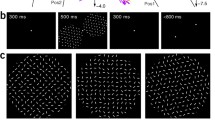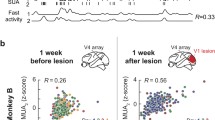Summary
Damage to visual cortical areas 17, 18, and 19 in the cat produces severe and long-lasting deficits in performance of form and pattern discriminations. However, with extensive retraining the animals are able to recover their ability to discriminate form and pattern stimuli. Recent behavioral experiments from this laboratory have shown that a nearby region of cortex, the lateral suprasylvian visual area (LS area), plays an important role in this recovery (Wood et al., 1974; Baumann and Spear, 1977b). The present experiment investigated the underlying neurophysiological mechanisms of the recovery by recording from single neurons in the LS area of cats which had recovered from long-term visual cortex damage.
Five adult cats received bilateral removal of areas 17, 18, and 19. They were then trained to criterion on two-choice brightness, form, and pattern discriminations. Recording from LS area neurons was carried out after the behavioral training, from 3 to 7 months after the visual cortex lesions. The properties of these neurons were compared to those of LS area neurons in normal cats (Spear and Baumann, 1975) and in cats with acute or short-term visual cortex damage and no behavioral recovery (Spear and Baumann, 1979). The results showed that all of the changes from normal which were produced by acute visual cortex damage were also present after the behavioral recovery. Moreover, all of the response properties of LS area neurons which remain after acute visual cortex damage were present in similar form after the behavioral recovery. There was no evidence for any functional reorganization in the LS area concomitant with its role in the behavioral recovery.
These results suggest that functional reorganization plays little or no role in recovery from visual cortex damage in adult cats. Rather, the recovery of form and pattern discrimination ability appears to be based upon the functioning of residual neural processes in the LS area which remain after the visual cortex damage.
Similar content being viewed by others
References
Alder, S.W., Meikle, T.H.: Visual discrimination of flux-equated figures by cats with brain lesions. Brain Res. 90, 23–44 (1975)
Atencio, F.W., Diamond, I.T., Ward, J.P.: Behavioral study of the visual cortex of Galago senegalensis. J. Comp. Physiol. Psychol. 89, 1109–1135 (1975)
Baumann, T.P., Spear, P.D.: Evidence for recovery of spatial pattern vision by cats with visual cortex damage. Exp. Neurol. 57, 603–612 (1977a)
Baumann, T.P., Spear, P.D.: Role of the lateral suprasylvian visual area in behavioral recovery from effects of visual cortex damage in cats. Brain Res. 138, 445–468 (1977b)
Braun, J.J., Lundy, E.G., McCarthy, F.V.: Depth discrimination in rats following removal of visual neocortex. Brain Res. 20, 283–291 (1970)
Burrows, G.R., Hayhow, W.R.: The organization of the thalamo-cortical visual pathways in the cat. An experimental degeneration study. Brain Behav. Evol. 4, 220–270 (1971)
Camarda, R., Rizzolatti, G.: Visual receptive fields in the lateral suprasylvian area (Clare-Bishop area) of the cat. Brain Res. 101, 423–443 (1976)
Cornwell, P., Warren, J.M., Nonneman, A.J.: Marginal and extramarginal cortical lesions and visual discrimination by cats. J. Comp. Physiol. Psychol. 90, 986–995 (1976)
Dalby, D.A., Meyer, D.R., Meyer, P.H.: Effects of occipital neocortical lesions upon visual discriminations in the cat. Physiol. Behav. 5, 727–734 (1970)
Doty, R.W.: Functional significance of the topographical aspects of the retinocortical projection. In: Neurophysiologie und Psychophysik des visuellen Systems, R. Jung and H. Kornhuber (eds.), pp. 228–247. Berlin: Springer 1961
Doty, R.W.: Ablation of visual areas in the central nervous system. In: Handbook of sensory physiology, R. Jung (ed.), Vol. VII/3B, pp. 483–542. Berlin, Heidelberg, New York: Springer 1973
Garey, L.J., Powell, T.P.S.: The projection of the lateral geniculate nucleus upon the cortex in the cat. Proc. R. Soc. Lond. [Biol] 169, 107–126 (1967)
Gellermann, L.W.: Chance orders of alternating stimuli in visual discrimination experiments. J. Genet. Psychol. 42, 206–208 (1933)
Goldberger, M.E.: Recovery of movement after CNS lesions in monkeys. In: Plasticity and recovery of function in the central nervous system, D.G. Stein, J.J. Rosen, N. Butters (eds.), pp. 265–337. New York: Academic Press 1974
Goodman, D.C., Horel, J.A.: Sprouting of optic tract projections in the brain stem of the rat. J. Comp. Neurol. 127, 71–88 (1966)
Guillery, R.W.: Experiments to determine whether retinogeniculate axons can form translaminar collateral sprouts in the dorsal lateral geniculate nucleus of the cat. J. Comp. Neurol. 146, 407–420 (1972)
Hall, W.C., Diamond, I.T.: Organization and function of the visual cortex in hedgehog: II. An ablation study of pattern discrimination. Brain Behav. Evol. 1, 215–243 (1968)
Heath, C.J., Jones, E.G.: The anatomical organization of the suprasylvian gyrus of the cat. Ergeb. Anatomie 45, 1–64 (1971)
Hubel, D.H., Wiesel, T.N.: Visual area of the lateral suprasylvian gyrus (Clare-Bishop area) of the cat. J. Physiol. (Lond.) 202, 251–260 (1969)
Kennard, M.A.: Reorganization of motor function in the cerebral cortex of monkeys deprived of motor and premotor areas in infancy. J. Neurophysiol. 1, 477 (1938)
Lashley, K.S.: Brain mechanisms and intelligence. Chicago: University Chicago Press 1929
Lashley, K.S.: The mechanism of vision: XII. Nervous structures concerned in habits based on reactions to light. Comp. Psychol. Monogr. 11, 43–79 (1935)
LeVere, T.E.: Neural stability, sparing, and behavioral recovery following brain damage. Psychol. Rev. 82, 344–358 (1975)
Levey, N.H., Harris, J., Jane, J.A.: Effects of visual cortical ablation on pattern discrimination in the ground squirrel (Citellus tridecemlineatus). Exp. Neurol. 39, 270–276 (1973)
Lund, R.D., Lund, J.S.: Synaptic adjustment after deafferentiation of the superior colliculus of the rat. Science 171, 804–807 (1971)
Maciewicz, R.J.: Afférents to the lateral suprasylvian gyrus of the cat traced with horseradish peroxidase. Brain Res. 78, 139–143 (1974)
Murphy, E.H., Chow, K.L.: Effects of striate and occipital cortical lesions on visual discrimination in the rabbit. Exp. Neurol. 42, 78–88 (1974)
Murphy, E.H., Mize, R.R., Schechter, P.B.: Visual discrimination following infant and adult ablation of cortical areas 17, 18, and 19 in the cat. Exp. Neurol. 49, 386–405 (1975)
Mustari, M.J., Lund, R.D.: An aberrant crossed visual corticotectal pathway in albino rats. Brain Res. 112, 37–44 (1976)
Niimi, K., Sprague, J.M.: Thalamo-cortical organization of the visual system in the cat. J. Comp. Neurol. 138, 219–250 (1970)
Otsuka, R., Hassler, R.: Über Aufbau und Gliederung der corticalen Sehsphäre bei der Katze. Arch. Psychiatr. Z. Ges. Neurol. 203, 212–234 (1962)
Palmer, L.A., Rosenquist, A.C., Tusa, R.J.: The retinotopic organization of lateral suprasylvian visual areas in the cat. J. Comp. Neurol. 177, 237–256 (1978)
Pasik, P., Pasik, T., Schilder, P.: Extrageniculostriate vision in the monkey: Discrimination of luminous flux-equated figures. Exp. Neurol. 24, 421–437 (1969)
Pöppel, E., Held, R., Frost, D.: Residual visual function after brain wounds involving the central visual pathways in man. Nature 243, 295–296 (1973)
Ralston, H.J. III., Chow, K.L.: Synaptic reorganization in the degenerating lateral geniculate nucleus of the rabbit. J. Comp. Neurol. 147, 321–350 (1973)
Reinoso-Suarez, F.: Topographischer Hirnatlas der Katze für experimental-physiologische Untersuchungen. E. Merck A. G., Darmstadt 1961
Rhoades, R.W., Chalupa, L.M.: Functional and anatomical consequences of neonatal visual cortical damage in the superior colliculus of the golden hamster. J. Neurophysiol. 41, 1466–1494 (1978)
Rizzolatti, G., Camarda, R.: Inhibition of visual responses of single units in the cat visual area of the lateral suprasylvian gyrus (Clare-Bishop area) by the introduction of a second visual stimulus. Brain Res. 88, 357–361 (1975)
Rizzolatti, G., Camarda, R.: Influence of the presentation of remote visual stimuli on visual responses of cat area 17 and lateral suprasylvian area. Exp. Brain Res. 29, 107–122 (1977)
Rosenquist, A.C., Edwards, S.B., Palmer, L.A.: An autoradiographic study of the projections of the dorsal lateral geniculate nucleus and the posterior nucleus in the cat. Brain Res. 80, 71–94 (1974)
Rosner, B.S.: Recovery of function and localization of function in historical perspective. In: Plasticity and recovery of function in the central nervous system, D.G. Stein, J.J. Rosen, N. Butters (eds.), pp. 1–29. New York: Academic Press 1974
Sanderson, K.J.: The projection of the visual field to the lateral geniculate and medial interlaminar nuclei in the cat. J. Comp. Neurol. 143, 101–118 (1971)
Schneider, G.E.: Two visual systems. Science 163, 895–902 (1969)
Schneider, G.E., Jhaveri, S.R.: Neuroanatomical correlates of spared or altered function after brain lesions in the newborn hamster. In: Plasticity and recovery of function in the CNS. Stein, D.G. et al. (eds.), pp. 65–110. New York: Academic Press 1974
Snyder, M., Diamond, I.T.: The organization and function of the visual cortex in the tree shrew. Brain Behav. Evol. 1, 244–288 (1968)
Spear, P.D.: Behavioral and neurophysiological consequences of visual cortex damage: Mechanisms of recovery. In: Progress in psychobiology and physiological psychology, Vol. 8, J.M. Sprague, A.N. Epstein (eds.), pp. 45–89. New York: Academic Press 1979
Spear, P.D., Barbas, H.: Recovery of pattern discrimination ability in rats receiving serial or one-stage visual cortex lesions. Brain Res. 94, 337–346 (1975)
Spear, P.D., Baumann, T.P.: Receptive-field characteristics of single neurons in lateral suprasylvian visual area of the cat. J. Neurophysiol. 38, 1403–1420 (1975)
Spear, P.D., Baumann, T.P.: Effects of visual cortex removal on receptive field properties of neurons in the lateral syprasylvian visual area of the cat. J. Neurophysiol. 42, (in press) (1979)
Spear, P.D., Braun, J.J.: Pattern discrimination following removal of visual neocortex in the cat. Exp. Neurol. 25, 331–348 (1969)
Spear, P.D., Kalil, R.E.: Effects of neonatal visual cortex damage on lateral suprasylvian visual area neurons: Evidence for functional compensation. Neurosci. Abs. 3, 432 (1977)
Sprague, J.M., Levy, J., DiBerardino, A., Berlucchi, G.: Visual cortical areas mediating form discrimination in the cat. J. Comp. Neurol. 172, 441–488 (1977)
Tucker, T.J., Kling, A., Scharlock, D.P.: Sparing of photic frequency and brightness discriminations after striatectomy in neonatal cats. J. Neurophysiol. 31, 818–832 (1968)
Turlejski, K.: Visual responses of neurons in the Clare-Bishop area of the cat. Acta Neurobiol. Exp. (Warsz.) 35, 189–208 (1975)
Ward, J.P., Masterton, B.: Encephalization and visual cortex in the tree shrew (Tupaia glis). Brain Behav. Evol. 3, 421–469 (1970)
Weiskrantz, L.: Contour discrimination in a young monkey with striate cortex ablation. Neuropsychol. 1, 145–164 (1963)
Weiskrantz, L., Warrington, E.K., Sanders, M.D., Marshall, J.: Visual capacity in the hemianopic field following a restricted occipital lesion. Brain 97, 709–728 (1974)
Wetzel, A.B., Thompson, V.E., Horel, J.A., Meyer, P.M.: Some consequences of perinatal lesions of the visual cortex in the cat. Psychon. Sci. 3, 381–382 (1965)
Winans, S.S.: Visual form discrimination after removal of the visual cortex in cats. Science 158, 944–946 (1967)
Winans, S.S.: Visual cues used by normal and visual-decorticate cats to discriminate figures of equal luminous flux. J. Comp. Physiol. Psychol. 74, 167–178 (1971)
Wood, C.C., Spear, P.D., Braun, J.J.: Effects of sequential lesions of suprasylvian gyri and visual cortex on pattern discrimination in the cat. Brain Res. 66, 443–466 (1974)
Wright, M.J.: Visual receptive fields of cells in a cortical area remote from the striate cortex in the cat. Nature 223, 973–975 (1969)
Author information
Authors and Affiliations
Rights and permissions
About this article
Cite this article
Spear, P.D., Baumann, T.P. Neurophysiological mechanisms of recovery from visual cortex damage in cats: Properties of lateral suprasylvian visual area neurons following behavioral recovery. Exp Brain Res 35, 177–192 (1979). https://doi.org/10.1007/BF00236793
Issue Date:
DOI: https://doi.org/10.1007/BF00236793




